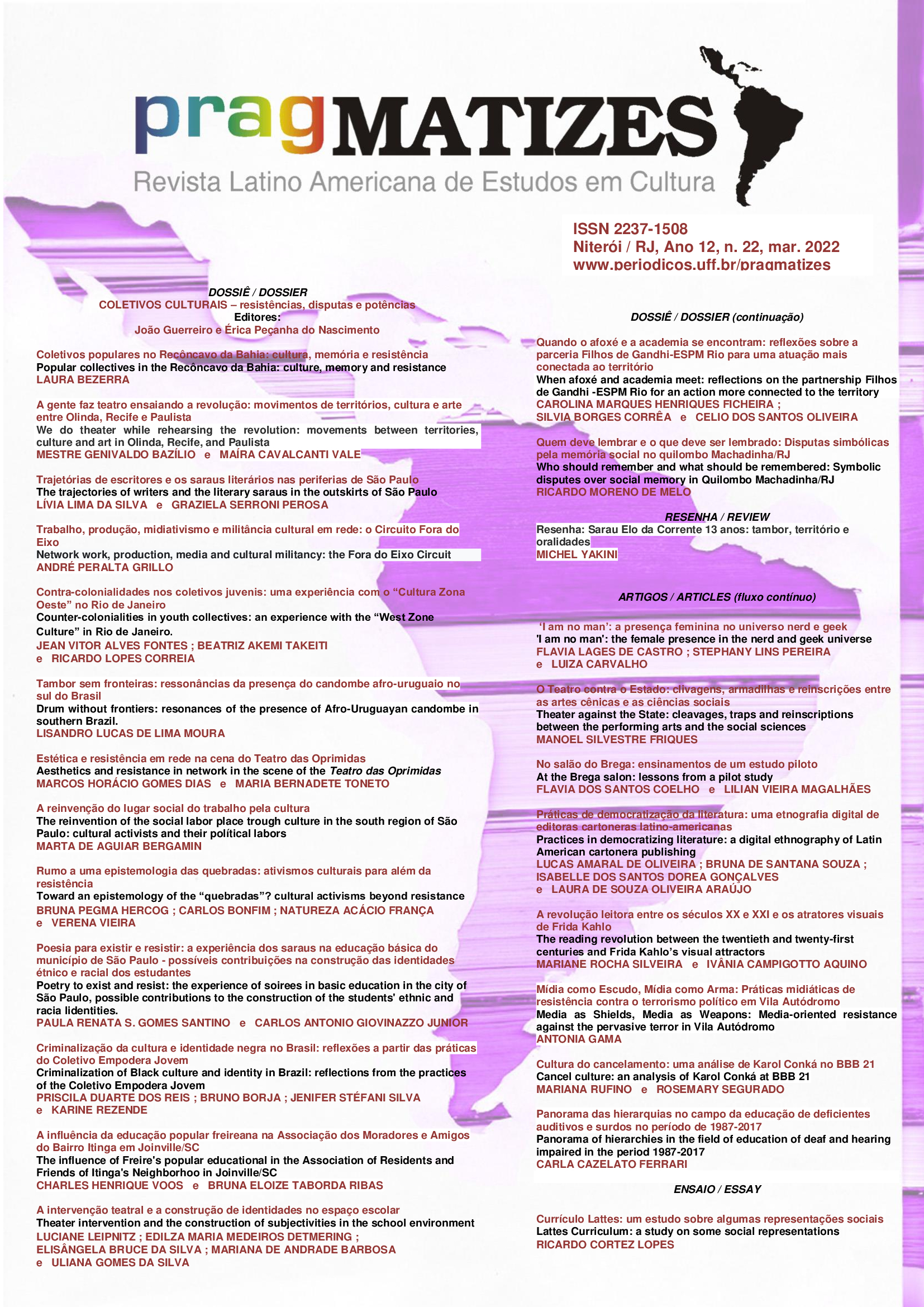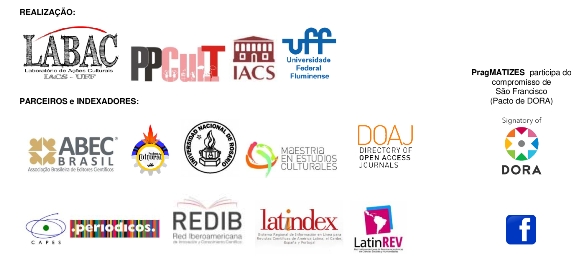Drum without frontiers
resonances of the presence of Afro-Uruguayan candombe in southern Brazil
DOI:
https://doi.org/10.22409/pragmatizes.v12i22.51358Keywords:
Afro-Uruguayan candombe, drums, frontier, cultural collectivesAbstract
The article narrates the trajectory of the creation of a musical collective of Afro-Uruguayan candombe in southern Brazil, in the region of the campaign, bordering Uruguay. The initiative is linked to the project Tambor Sem Fronteiras, coordinated by Brazilian members of the Pampa Sem Fronteiras Culture Point, in the city of Bagé (RS), among which is the author of this text. This is a cross-border action of integration and exchange between cultural groups from Brazil and Uruguay, aiming at the difusion of the musical practice of candombe on the Brazilian side of the border. The social, artistic and cultural actions of the collective of drummers converged for the formation of a cultural corridor of border strip (or a route of drums) based on rhythmic learning and coexistence with candombe comparsas from the interior of Uruguay. The text therefore presents a discussion about the effects, affections and controversies generated by the transit of piano, chico and repique drums beyond geographical borders. By following the route traced by the drums, border cultural agents weave common stories between Afro-Brazilian and Afro-Uruguayan cultures, often perceived as independent and separated by national boundaries, as well as proposing other forms of occupation of the public space of the street, anchored in the resonant and affecting presence of candombe drums.
Downloads
References
ALMEIDA, Ricardo. Fronteiras culturais: metáforas ou realidades? Revista P2P e Inovação, v. 5, n. 1, p. 260-275, 2018. DOI: 10.21721/p2p.2018v5n1.p260-275 Acesso em: 24 jul. 2021.
APPADURAI, Arjun. The Social Life of Things. Commodities in Cultural Perspective. Cambridge: Cambridge University Press, 1986.
AROM, Simha. Polyphonies et polyrythmies instrumentals d'Afrique centrale. Structure et méthodologie, 2 tomes. Ethnomusicologie 1. Paris: SELAF, 1985.
AYESTARÁN, Lauro. El folklore musical uruguayo. Montevideo: Arca, 1985.
AYESTARÁN,Lauro. El tamboril afro-uruguayo. Segunda Conferencia Interamericana de Etnomusicología realizada em La Universidad de Indiana, em 1965. In. LIST, George; ORREGO-SALAS, Juan (comp.). Music in the Americas, Indiana: Ed. Indiana University Research Center in Anthropology, Folklore, and Linguistics ; La Haya: Ed. Mouton & Co., 1967. p. 23-40.
CLIFFORD, James. Routes. Traveland Translation in the Late Twentieth Century. Harvard: Harvard University Press, 1997.
CÔRTES, Paixão. Folclore Gaúcho: festas, bailes, música e religiosidade rural. Porto Alegre: Editora CORAG, 2006.
CORUJA, Antônio Alvares P. Antigualhas: reminiscências de Porto Alegre. Porto Alegre: Tipografia do Jornal do Comércio, 1881.
DORFMAN, Adriana. A condição fronteiriça diante da securitização das fronteiras do Brasil. In: NASCIMENTO, D.; PORTO,J. Fronteiras em perspectiva comparada e temas de defesa da Amazônia. Belém: EDUFBA, 2013.
EVANS-PRITCHARD, Edward Evan. A dança. In. CAVALCANTI (org.). Ritual e Performance: 4 estudos clássicos. Rio de Janeiro: 7Letras, 2014.
FERREIRA, Luis. Concepciones cíclicas y rugosidades del tiempo en la práctica musical afroamericana: un estudio a partir del candombe en Uruguay. In. AHARONIÁN, Coriún (coord..). La música entre África y América. Centro de Documentación Musical Lauro Ayestarán (CDM), Montevideo: Biblioteca Digital, 2013. p. 231-261.
FERREIRA, Luis. La Música Afrouruguaya de Tambores em la Perspectiva Cultural Afro-Atlántica. Anuário de Antropologia Social y Cultural em Uruguay, Montevidéu, v. 1, p. 41-57, 2001.
FERREIRA, Luis. Los tambores del candombe. Montevideo: Ediciones Colihué – Sepé, 1997.
FERREIRA, Luis. Música, artes performáticas y el campo de las relaciones raciales. Área de estudios de la presencia africana en América Latina. In.: Los estudios afroamericanos y africanos en América Latina: herencia, presencia y visiones del otro. Buenos Aires: CLACSO, 2008.
FREIRE-MEDEIROS, Bianca; LAGES, Mauricio Piatti. A virada das mobilidades: fluxos, fixos e fricções, Revista Crítica de Ciências Sociais, 123, p. 121-142, 2020.
GELL, Alfred. Arte e agência: uma teoria antropológica. [Tradução de Jamille Pinheiro Dias] [Coleção Argonautas]. São Paulo: Ubu Editora, 2018.
GILROY, Paul. O Atlântico Negro: modernidade e dupla consciência. [Tradução de Cid Knipel Moreira]. São Paulo: Editora 34 ; Rio de Janeiro: Universidade Cândido Mendes, Centro de Estudos Afro-Asiáticos, 2012.
JURE, Luis. Principios generativos del toque del repique del candombe. In AHARONIÁN, Coriún (ed.). La música entre África y América. Montevideo: Centro Nacional de Documentación Musical Lauro Ayestarán, Ministerio de Educación y Cultura del Uruguay, 2013.
KUBIK, Gerhard. Pesquisa musical africana dos dois lados do Atlântico: algumas experiências e reflexões pessoais. Revista USP, (77), p. 90-97, 2008.
KUBIK, Gerhard. The Phenomenon of Inherent Rhythms in East and Central African Instrumental Music. African Music, vol. 3, no. 1, 1962.
MACHADO, Lia; NOVAES, André; MONTEIRO, Lício. Building Walls, Breaking Barries: territory, integration and rule of law in frontier zones. Journal od Borderlands Studies, vol. 24, nº 3, 2009.
MACIEL, Carla Michele S. Mãe Rita como símbolo de poder sócio-religioso a partir de seus axós e ilequês. (Graduação em Artes). Universidade Federal do Rio Grande do Sul, Porto Alegre, 2019.
MAIA, Mario de Souza. O Sopapo e Cabobu: etnografia de umatradiçãopercussiva no extremosul do Brasil. (Doutorado em Música). Universidade Federal do Rio Grande do Sul, Porto Alegre, 2008.
MAIA, Mario de Souza. Transpondo fronteiras, migrando de contextos: etnografando uma tradição percussiva no extremo sul do Brasil. In.: LUCAS, Maria Elizabeth. Mixagens em campo: etnomusicologia, performance e diversidade musical. Porto Alegre: Marca visual, 2013.
MBEMBE, Achille. A ideia de um mundo sem fronteiras. Tradução de Stephanie Borges. Revista Serrote, São Paulo/Instituto Moreira Salles, março de 2019.
MOURA, Lisandro L. L. Aprender com tambores: o candombe afro-uruguaio como prática de educação. (Doutorado em Antropologia). Universidade Federal de Peltoas/UFPel, 2021.
MOURA, Lisandro L. L.; DE CARVALHO LEITE, Matheus. Tambor, Canção ePoesia, com Mimmo Ferreira e Richard Serraria. Revista Diálogos Culturais, Bagé,v. 1, p.24-27, 04 dez. 2015.
NANCY, Jean-Luc. À l'écoute. Paris:,Éditions Galillée, 2002.
OLIVERA CHIRIMINI, Tomás; VARESE, Antonio. Candombe. Montevideo: Ediciones de la Banda Oriental, 2018.
PANITZ, Lucas Manassi. Redes musicais e [re]composições territoriais no Prata: poruma Geografia da Música em contextos multi-localizados.(Doutorado em Geografia). Universidade Federal do Rio Grande do Sul, Porto Alegre, 2017.
PICÚN, Olga. Cambio, identidad y crítica: el candombe enelmovimiento de la Música Popular Uruguaya. In: Dossier thématique: Exils, migrations et identitédansl’imaginaireibéro-américain, coord. par Michel Bœglin, Cahiers d’études dês cultures ibériques et latino-américaines – CECIL, no 2, ano 2016.
PLASTINO, Virna V.¡FUERZA!Os tambores de candombe e suas pessoas, em Ansina, Montevidéu. (Doutorado em Antropologia Social). Museu Nacional/Universidade Federal do Rio de Janeiro, 2013.
RAMIL, Vitor. A Estética do Frio: Conferência de Genebra. Porto Alegre: Satolep, 2004.
SANTANA, Tiganá. Ensaio inclinado ao tambor. Revista Claves, João Pessoa/UFPB, volume 9, número 14, , 2020.
SERRARIA, Richard. Mais Tambor Menos Motor e a Criação de Canções. (Doutorado em Literatura Brasileira). Universidade Federal do Rio Grande do Sul, Porto Alegre, 2017.
SERRARIA, Richard. Mormaço do sopapo: carne de sal, canção e cansaço. Blog do autor. Porto Alegre, 20 jul. 2011.
SILVEIRA,Flávio L. A. As complexidades da noção de fronteira, algumas reflexões. Caderno Pós Ciências Sociais, São Luís, v. 2, n. 3, p.17-38, jan./jun. 2005.
SIMAS, Luis Antonio. O corpo encantado das ruas. Rio de Janeiro: Civilização Brasileira, 2019.
TURINO, Thomas. Music as social life: the politics of participation. Chicago: The University of Chicago Press, 2008.
URRY, John. Mobilities. Cambridge: Polity Press, 2007.
VIDAL E SOUZA, Candice; GUEDES, André Dumans. Antropologia das mobilidades. Brasília: ABA Publicações, 2021.
WISNIK, José Miguel. Sincopação do Mundo: Dinâmicas da Música e da Cultura - PGM 02. São Paulo: UNIVESP TV[S.l: s.n.], Ano: 17, jan. 2016.
Published
How to Cite
Issue
Section
License

This work is licensed under a Creative Commons Attribution 4.0 International License.
By forwarding an original to PragMATIZES, the authors agree that the copyright related to it is transferred to the Publishing. Articles and other writings are made available in PDF format from their publication, and they can be downloaded to institutional repositories and personal pages, provided that with their proper bibliographic indication.



